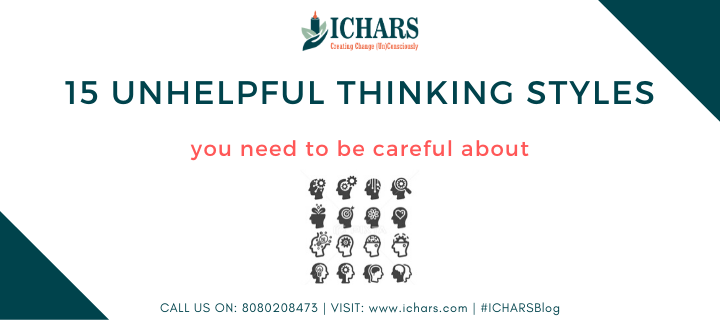Introduction
We communicate with ourselves with the help of our thoughts. The quality of our thoughts is one of the key elements that determines the quality of our life.
Sometimes due to certain experiences in early childhood, our culture, or our social circle, our thought processes can become unhealthy, irrational or distorted!

This can lead to us developing unhelpful thinking styles. We generally unconsciously indulge in them just before and during distressing situations. These unhelpful thinking styles can have a major influence on the way we perceive and live our lives.
Understanding these unhelpful thinking styles and distortions, can help you notice them. Once you learn to notice these styles and catch yourself indulging in them, you can challenge or distance yourself from these thoughts and distortions. This can help you see the situation in a different and more helpful way.
Defining Distortions
The Oxford Dictionary defines the word ‘distort’ as,
- Pull or twist out of shape
- Give a misleading or false account or impression of
We often convince ourselves that these distorted thoughts or cognition’s are true. This conviction may lead to us having irrational beliefs about ourselves or others.
Since our thoughts and beliefs influence our lives, we must learn to manage our thinking styles. But before we can learn to manage them, we need to first be aware of the different ways in which we distort our thoughts.

Luckily for us, Aaron Beck in his theory of cognitive distortions has already done most of the work.

David Burns built on his work, classified these different ways of distortions into 15 thinking styles. He named each of the thinking styles and provided us with relevant examples.
Let’s look into each of them in detail.
Types of Unhelpful Thinking Styles
Filtering:
- A person using this style of thinking might take the negative details and magnify them. The person filters out all the positive aspects of a situation.
- I am sure you can think of someone who has a tendency to distort and generalise situations in such a manner that they are not able to see anything positive? It is probably because they’re just FILTERING everything positive.
Polarised Thinking:
- As the name suggests, POLAR means literally the other end – either north or south, black or white, good or bad. Things are either perfect or a failure. There is no middle way!
- For someone having such a thinking style, they may never be able to see the grey in their life. If they consider someone in their acquaintance as mean or selfish then that person is going to stay mean forever or if someone is good, they’re going to stay the same.
- If such a person enters a race, s/he will feel good only if s/he wins since any other outcome will seem a failure to him/her the second and third position holds no space.
Over-generalisation:
- Do you know someone for whom a single or couple of incidences are enough to generalise?
- For example: If a student fails in a subject, the teacher GENERALISES that the student is going to fail in all the papers.
Mind Reading:
- An example of this style of thinking would be; I may not be angry about a certain situation or someone’s action, but my sister is READING MY MIND by stating that I am angry right now or when someone says I know what you’re thinking.
- This style of thinking involves a person jumping to a conclusion about what the other person might be thinking and feeling exactly in that situation.
Catastrophizing:
- When a person is using this style of thinking, s/he expects things to fail or end in a disaster in the end. Their thought process comprises of “WHAT IF’s”. They will either maximise or minimise the problem to such an extent that it won’t sound healthy.
- If some tragedy occurs, they will keep on imagining what if it happens to them?
- For Example: Rahul is someone who thinks that if he doesn’t pass his exam, he will end up losing his friends, and further won’t get a good job and then he will not be able to get married and will be lonely all his life!
Personalization:
- This style of thinking lets people think that everyone around them is having a reaction to everything that they are doing. They are suspicious of everyone.
- The person may also compare themselves with others, trying to understand who is smarter, better etc.
- For example, Shalini thinks whenever she enters her class everyone laughing is joking about her.
Control Fallacies:
- In this style of thinking, people generally have either of the following two beliefs – about being in complete control of every situation; externally controlled and internally controlled.
- When someone thinks they’re externally controlled they feel someone else is controlling them. They don’t have any control on their life. They feel they are victims of fate and luck or someone around them, who has a powerful personality, is controlling them.
- For example: Jeet thinks that because his supervisor is strict and usually not in a good mood, he is unlucky. And so, he is going to fail his paper.
- When a person feels that everything is internally controlled, they blame themselves for everything that is happening in their surroundings. Someone with such a style might think that the other person is unhappy because of them!
- For example; Mohini feels guilty for her best friends’ death because she cancelled her plan with Rachel, and she went for that road trip with her other friends while Rachel met with a road accident.
Fairness fallacy:
- Do you know of someone who is often resentful, angry or feels hopeless about most of the situations? They have this belief that things will not always work out in their favour, even when they should.
- In Fallacy of Fairness, a person becomes resentful as other people won’t agree with what they think is fair.
- Usually, it is said that “life isn’t always fair” and few people swear by these lines and feel it is always true in their case. Nothing is fair with them!
Blaming:
- A person might blame someone else for what they’re going through, specifically a bad phase. Or blame themselves for everything wrong in their life.
- For example, when someone says ‘you are the reason I cry so much and have failed my exams’ they are literally blaming someone else for their failure in the exams and a low mood.
Should:
- Some people feel that they ‘should’ and ‘ought’ to do something that they have decided or someone else is expected to do. Their thoughts are very rigid without any scope of flexibility.
- The emotional consequence is guilt. When a person directs should statements toward others, they often feel frustrated and angry.
- For example, your boss says, you SHOULD always finish your work and never considers your shortcomings or personal struggles with the given work!
Emotional Reasoning:
- Have you met a few people who eat less because they ‘feel’ fat! But, they’re not fat but they just feel like they are heavy. That is even when they have proof of their weight, they deny it and focus more on how they feel.
- In this kind of thinking style, a person starts considering their emotions over rational thinking, they think that ‘If I am feeling something then I should hold it true’.
- The person might not be boring or stupid but just because he or she is feeling that they are boring they consider it as a reality! Since they felt it.
The fallacy of Change:
- The person expects other people to change by just pressurising them or using other ways.
- The only aim behind doing this is the person feels if they change the other person, they will be perfect. They place their demands on other people because their hope of happiness depends on the other person.
- For example, a wife who tries to get her husband to improve his appearance and manners, in the belief that her husband is perfect in every other way and he will make her happy if he only changed these few minor things.
Global Labelling:
- When a person is mislabelling either someone else or themselves, it is considered distorted thinking.
- A person using this style won’t be describing an error in the context of a specific situation, instead, will attach an unhealthy universal label to themselves or others.
- It involves describing an event with language that is very overgeneralised and coloured for no reason.
- For example, instead of saying Sheela drops her children off at day-care every day, Sunaina says that “She abandons her children to strangers.”
Being Right:
- Do you know of someone who always tries to prove that their opinions and actions are correct? Such a person would go to any lengths to prove that they’re correct.
- For example, Madhuri says “I don’t care how badly arguing with me makes you feel, I’m going to win this argument no matter what, because I’m right.” For her, being right often comes before the feelings of others around her, even her loved ones.
Heaven’s Reward Fallacy:
- The final distorted style of thinking is a false belief that a person’s sacrifice and self-denial will eventually pay off as if some global force is keeping score.
- Some people may carry this belief that ‘because in a fair world, the people who work the hardest will get the largest reward’. A person who sacrifices and works hard but doesn’t experience the expected payoff, will usually feel bitter when the reward doesn’t come.
Managing Unhelpful Thinking Styles with Cognitive Hypnotic Psychotherapy
Cognitive Hypnotic Psychotherapy (CHP) effectively addresses and transforms unhelpful thinking styles through a comprehensive and integrative approach. Here’s how CHP can help manage these distorted thought patterns:
- Identifying Distorted Thoughts: CHP helps clients recognize unhelpful thinking styles, understanding their origins and impacts.
- Integrative Techniques: Combining cognitive, behavioral, psychodynamic, and humanistic methods, CHP provides a tailored approach to each client’s unique needs.
- Subconscious Access: Using hypnosis, CHP uncovers deep-seated beliefs and unresolved issues contributing to negative thought patterns.
- Reframing Thoughts: CHP employs cognitive-behavioral techniques to restructure negative thoughts, promoting healthier thinking patterns.
- Emotional Regulation: Integrating mindfulness and emotional empowerment, CHP helps clients manage emotions, reducing distressing thoughts.
- Self-Awareness: CHP encourages introspection, increasing self-awareness and understanding of thought processes.
- Behavioral Changes: Behavioral techniques guide clients in adopting positive behaviors, counteracting unhelpful thinking styles.
- Personalized Therapy: Each therapy plan is tailored to the client’s specific needs, enhancing therapeutic outcomes.
Cognitive Hypnotic Psychotherapy provides an effective framework for managing unhelpful thinking styles. By integrating various therapeutic approaches and promoting self-awareness, CHP helps clients overcome distorted thoughts and achieve a healthier mindset. For mental health professionals, learning CHP offers significant benefits in addressing complex client needs.
If you are a mental health professional who would like to learn to help your clients change automatic thought patterns and overcome limiting beliefs, check out the Cognitive Hypnotic Psychotherapy Diploma that seamlessly integrates different approaches to psychotherapy (Cognitive, Behavioural, Psycho-dynamics and Humanistic) into a single curriculum.

